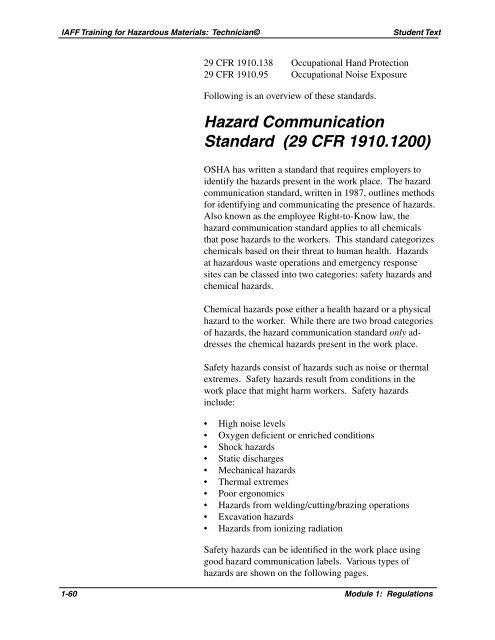Module 1: Regulations - International Association of Fire Fighters
Module 1: Regulations - International Association of Fire Fighters
Module 1: Regulations - International Association of Fire Fighters
Create successful ePaper yourself
Turn your PDF publications into a flip-book with our unique Google optimized e-Paper software.
IAFF Training for Hazardous Materials: Technician© Student Text<br />
29 CFR 1910.138 Occupational Hand Protection<br />
29 CFR 1910.95 Occupational Noise Exposure<br />
Following is an overview <strong>of</strong> these standards.<br />
Hazard Communication<br />
Standard (29 CFR 1910.1200)<br />
OSHA has written a standard that requires employers to<br />
identify the hazards present in the work place. The hazard<br />
communication standard, written in 1987, outlines methods<br />
for identifying and communicating the presence <strong>of</strong> hazards.<br />
Also known as the employee Right-to-Know law, the<br />
hazard communication standard applies to all chemicals<br />
that pose hazards to the workers. This standard categorizes<br />
chemicals based on their threat to human health. Hazards<br />
at hazardous waste operations and emergency response<br />
sites can be classed into two categories: safety hazards and<br />
chemical hazards.<br />
Chemical hazards pose either a health hazard or a physical<br />
hazard to the worker. While there are two broad categories<br />
<strong>of</strong> hazards, the hazard communication standard only addresses<br />
the chemical hazards present in the work place.<br />
Safety hazards consist <strong>of</strong> hazards such as noise or thermal<br />
extremes. Safety hazards result from conditions in the<br />
work place that might harm workers. Safety hazards<br />
include:<br />
• High noise levels<br />
• Oxygen deficient or enriched conditions<br />
• Shock hazards<br />
• Static discharges<br />
• Mechanical hazards<br />
• Thermal extremes<br />
• Poor ergonomics<br />
• Hazards from welding/cutting/brazing operations<br />
• Excavation hazards<br />
• Hazards from ionizing radiation<br />
Safety hazards can be identified in the work place using<br />
good hazard communication labels. Various types <strong>of</strong><br />
hazards are shown on the following pages.<br />
1-60 <strong>Module</strong> 1: <strong>Regulations</strong>
















